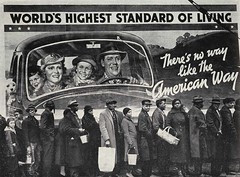Photography is a global story: from San Francisco to Paris to Rochester to Frankfurt (the Leica camera). It is a story of burgeoning technology: from Daguerreotypes to roll film to pixels. And it's a story of social impact: Brady and the US Civil War, Adams and the national forests, Riis and NYC poverty, Life Magazine and the world in the 1950's and 1960's (ex: the Civil Rights movement).
Today's photo is a famous one by photojournalist Margaret Bourke-White. Taken during the Great Depression (1930 - 1940), this photo of jobless people in a line for a soup kitchen shows the ironic nature of US government propaganda.
Bonus / independent work:
* Research & compare photojournalists Henri Cartier-Bresson and Gordon Parks.
* Research & compare artist Andy Warhol and celeb photog Annie Leibovitz.
* Research & compare National Geographic Magazine and Life Magazine.
* Research & compare the Polaroid camera with the digital camera.
Objectives:
* Explain how technological advances have led to increasing interaction between
regions (e.g., use of satellites for monitoring and exploration) (G-1B-H3)
* Identify technological advances that expanded human capacity to
modify the environment (e.g., steam, coal, electric, nuclear power,
levees) (G-1D-H1)
Sunday, January 22, 2006
Subscribe to:
Post Comments (Atom)


No comments:
Post a Comment